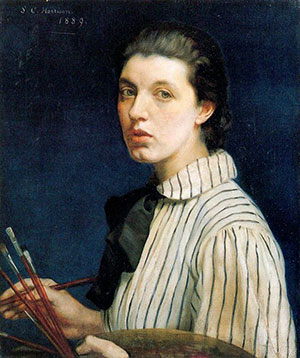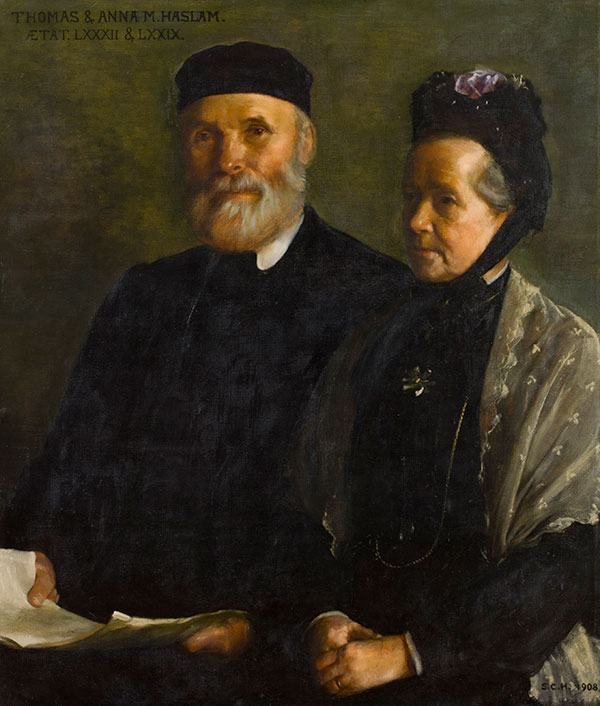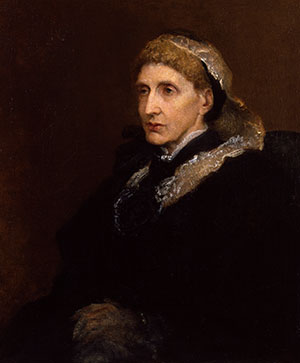By Hannah Baker

Portrait-painter and social reformer Sarah Cecilia Harrison (1863–1941) was born in Holywood, Co. Down. After the death of her father in 1873 her family relocated to London, a move that would ultimately benefit Harrison, as in 1878 she began her artistic training at the Slade School of Fine Art. She valued her education and was a talented student, winning several awards for her studies, including a scholarship of £50 per annum for three years in 1882, which meant that she continued her training until 1885. In 1904 Harrison moved to Dublin and successfully established a career as a portrait-painter. She regularly received portrait commissions from prominent individuals in Dublin society, and her work hangs in the Royal College of Physicians, the National Maternity Hospital, the King’s Inns and the Kildare Street University Club.
In addition to her portrait-painting practice, Harrison was well known for her work in highlighting and addressing the needs of the poor in society. This manifested itself in numerous responsibilities, including roles as honorary secretary to the Married Men’s Relief Committee, which she undertook in 1905, and as founder and honorary secretary of the Dublin City Labour Yard in 1906. Harrison was also a pioneer for women’s suffrage and served as chairwoman of the Women’s Civic Union in 1917. In conjunction with these endeavours, in January 1912 she became the first woman in Dublin to be elected as a city councillor. During her election campaign it was Anna Haslam (1829–1922), one of the subjects of this double portrait, who convened a meeting to hear her address. Furthermore, once Harrison was elected, Anna Haslam spoke at the event for the presentation of Harrison’s municipal robes, commending Harrison’s work both as an artist and as an advocate for the poor in Dublin.
Anna and Thomas Haslam
Anna Haslam and her husband, Thomas Haslam (1825–1917), were social reformers and particularly dedicated to the advancement of the rights of women in all areas of society. Between 1869 and 1870 they were associated with the campaign for the repeal of the Contagious Diseases Act, which authorised the inspection of prostitutes to prevent the spread of venereal disease, particularly in army camps. It gave the government the power to arrest women suspected of being prostitutes; if found guilty, they would be subjected to internal examinations every fortnight and potential imprisonment. Anna Haslam served as an executive committee member of the National Association for the Repeal of the Contagious Diseases Act. In 1869 the Ladies’ National Association for Repeal of the Acts was established, and the Haslams expanded this association in 1870 by setting up a branch in Dublin. Anna continued to establish reform committees and associations, one example being the foundation of the Irish Women’s Suffrage and Local Government Association in 1876. Thomas Haslam was committed to writing on the subject of women’s rights and women’s suffrage; notable pamphlets authored by him were The rightful claims of women: an address (1906) and Some last words on women’s suffrage (1916), the year before he died.

‘Holbein-like’
Harrison painted this double portrait of the Haslams in 1908. It is likely that she initiated the project, as the painting remained in her possession once finished. On its completion, she was highly praised in the Irish Times by the artist and architect Richard Caulfield Orpen (1863–1931):
‘Miss Harrison combines that intense and reverent sympathy with her subject, and a rare technical skill, without which all portraiture must be cold and lifeless, or merely a medium used for the display of the painter’s caprice.’
Orpen also described Harrison’s technique as ‘Holbein-like’. Indeed, critics throughout her career compared Harrison’s artwork with that of Hans Holbein the Younger (1497/8–1543). For example, an article on the 1891 exhibition at the New English Art Club claimed that Harrison was ‘looking at Holbein at least as usefully as many of her contemporaries are wont to look upon Velasquez’. Holbein’s portrait of William Reskimer, in the Royal Collection at Hampton Court Palace, is an example of design akin to that seen in Harrison’s portrait of Anna and Thomas Haslam. Moreover, a method of painting reliant on the accuracy of outlined forms is evident in both Holbein’s and Harrison’s portraits. This can be clearly discerned in Harrison’s painting in the contour of Anna Haslam’s nose, which consists of a single dark line. This method may appear to be a simplistic approach to portrait-painting but it permits no room for error. Other artists contemporaneous with Harrison, such as John Butler Yeats (1839–1922) and Sarah Purser (1848–1943), used a different approach, constructing forms through blocks of skin tones and shadow, which led to a suggestion of an outline rather than commitment to a specific stroke. Thus Harrison’s accuracy in this portrait is an apt example of the rare technical skill described by Orpen.
Her linear method of application was a consequence of her training at the Slade. French-born artist Alphonse Legros (1837–1911) was Professor of Fine Art during Harrison’s long tenure. He favoured a traditional academic approach to painting and drawing and promoted this practice throughout his teaching. Harrington Mann (1864–1937), Harrison’s fellow student at the Slade, described Legros’s technique in his manual on painting, stating that Legros had a hierarchy when painting and favoured the use of line over both tone and colour. Whilst he used all three elements, he saw colour as the least important aspect of a painting. Harrison’s palette was similar in tonal range to that of her teacher.
George Frederic Watts

Another artist who influenced Harrison’s work, and the double portrait of Anna and Thomas Haslam in particular, was George Frederic Watts (1817–1904). Watts was well known to Harrison, not only as a distinguished London-based artist but also as a close friend of Legros. Furthermore, his second wife, Mary Seton Watts (1849–1938), was a student at Slade. Throughout his career Watts produced a collection of portrait paintings—now described as his ‘Hall of Fame’—in which he depicted those of his contemporaries whom he deemed worthy of representation and immortalisation, such as social reformers Samuel Augustus Barnett (painted in 1887), John Passmore Edwards (1894) and Josephine Butler (1895). His motivation for the creation of this series was to gift the work to the nation, and these portraits now reside in the collection of the National Portrait Gallery in London.
Harrison, in a similar manner to Watts, chose to represent the two Haslams in order to promote the causes that they supported. Harrison’s friend Sir Hugh Lane (1875–1915) optimistically believed that the inclusion of a reproduction of the Haslams’ portrait in a popular journal would help to advance the cause of women’s suffrage (it didn’t). Harrison also echoed Watts’s philosophy with regard to gifting work to the nation. She had originally sought to present the double portrait of the Haslams to Dublin’s Municipal Gallery of Modern Art (now the Hugh Lane Gallery), but Lane, who was also director of the gallery project, refused her gift and instead purchased it from her as a mark of respect for both Harrison’s reputation and that of the sitters.
A further connection between Watts and Harrison can be found in Josephine Butler, painted by Watts because of her work for poorer women in society. Butler was secretary to the Ladies’ National Association for Repeal of the Contagious Diseases Acts and a friend and associate of the Haslams. Harrison chose to depict Anna Haslam in a pose and dress comparable to those of Josephine Butler in the portrait by Watts. The difference in design in the Haslam painting is the direction of the light falling on the face of the sitters. Anna Haslam sits in almost complete shadow, unlike Butler. This shadow pattern would have posed a far greater challenge for Harrison in rendering accurate shapes; nevertheless, it did not deter her, and her technical prowess was rewarded with commendations for her work in the press.
When the double portrait was first exhibited at the Franco-British Exhibition in 1908, Lane wrote to Harrison to inform her that the artist John Lavery (1856–1941) and some art critics from France were very impressed with the work. Harrison’s competence in rendering accurate representations was remarked upon in an article written on the Ulster Arts Club exhibition of 1910, in which this painting was exhibited. The critic praised Harrison’s ability to depict a truthful likeness of the Haslams and credited it with being one of the best oil paintings in the exhibition. The painting was also used to promote the cause of women’s suffrage when it was reproduced in the Irish Citizen in November 1915 alongside an article on Thomas Haslam and his work for the suffrage movement. The success of this portrait endured and in 1923 the Dublin Evening Telegraph declared it one of the best paintings in the Municipal Gallery collection. Today, as Harrison had envisaged, the painting is on permanent display in the Hugh Lane Gallery, a fitting tribute to the achievements of both artist and sitters alike.
Hannah Baker is a Ph.D candidate at Trinity College Dublin and an Irish Research Council Government of Ireland postgraduate scholar.
Further reading
M. Cappock (ed.), Sarah Cecilia Harrison (1863–1941): artist, social campaigner and city councillor (Dublin, 2022).
